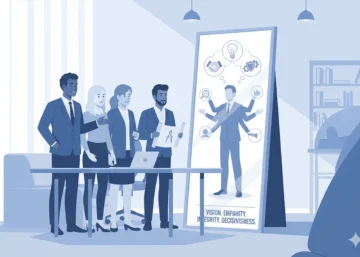There’s an old stereotype about a tense (and imaginary) working truce that exists in a hypothetical middle management vs leadership standoff, and it goes something like this: senior leadership, engaged with high strategy and abstract models, mandates implementation of the latest management trend, while middle managers on the ground with the workers roll their eyes and do their best to mitigate the negative impact of the mandate.
In WW1, it was the arrogant general ordering troops to charge directly into enemy fire against the advice of the front-line officers…
… or Afghanistan in 2002, when officials inside the Pentagon intervened in military encounters thousands of miles away based on live satellite imagery, against real-time intelligence from commanders on the ground.
While it may seem that middle management vs leadership friction is inevitable due to the differing perspectives and priorities of the two sides, this doesn’t have to be the case. If senior leaders are prescient enough to empower their middle managers to lead organizational change initiatives, and are willing to step back to interpret the results of initiatives and manage the overall direction, the two sides are capable of achieving things together neither could do on their own.
The Role of Senior Leadership
Creating dynamic, collaborative synergy between middle management and senior leadership begins when senior leadership decides to step out and explore the usefulness of an unconventional management principle, which is:
Every resource and insight that your company requires to move forward
is already present within the people who work at your company.
Following this principle, senior leadership can assemble its entire workforce (or a representative subset) into a room and solicit their input on how they think the company should confront the challenges at hand – while at the same time providing feedback on the overall company culture.
In this scenario, senior leadership facilitates the creation of a common vision, and then champions it – empowering middle management to step forward and collaborate on projects and processes to bring that common vision to life.
Throughout, senior leadership is hardly passive. As it empowers middle management to lead and innovate, it is simultaneously analyzing and assessing the effectiveness of new projects and initiatives, lending or redirecting support to those that most effectively drive the common vision.
During this process, senior leadership encourages communication and collaboration across departments so that personnel from all different areas of the business can explore ideas together.
What is the managers’ role?
Middle Managers Drive Change
Empowered by senior leadership, members of middle management have an opportunity to step up and begin leading.
The process of leading is ongoing, as managers of various departments come together to generate ideas for implementing the common vision, and create or refine the systems required to implement those ideas. In this collaborative context, each person will get to practice listening and speaking, giving and receiving feedback, and developing a sense of personal responsibility for the group’s success.
Over time, these collaborative managers develop into collaborative senior leaders devoted to a common company vision – resulting in long-term transformation of organizational culture toward high performance leadership.
Case Study
While overseeing operations, strategy and finance at 20th Century Fox, I led the initiative to design and implement the studio digital supply chain. That supply chain needed to be versatile enough to create and distribute all the film and television elements for broadcast, cable and digital partners.
I knew nothing about digital supply chains, engineering, bit rates, etc. So I pulled together champions from all the affected areas of the studio and coached them to develop the vision and strategy for the supply chain — and they nailed it! They worked collaboratively and were completely engaged and aligned with the vision and strategy we developed together.
Conclusion
When senior leaders empower middle management as agents of change, and divest of the old middle management vs leadership paradigm, stepping back to interpret the results of initiatives and manage the overall direction of progress – true organizational transformation around collaboration, adaptability and innovation can take place.





